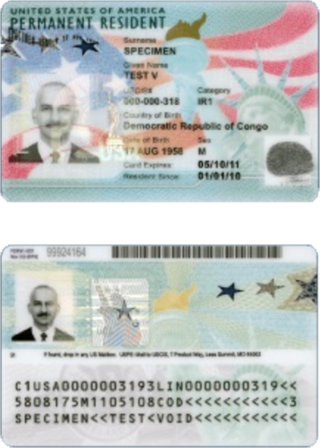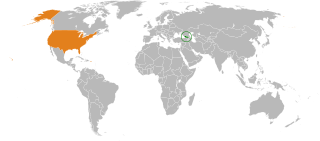Related Research Articles

A green card, known officially as a permanent resident card, is an identity document which shows that a person has permanent residency in the United States. Green card holders are formally known as lawful permanent residents (LPRs). As of 2019, there are an estimated 13.9 million green card holders, of whom 9.1 million are eligible to become United States citizens. Approximately 65,000 of them serve in the U.S. Armed Forces.
The H-1B is a visa in the United States under the Immigration and Nationality Act, section 101(a)(15)(H), that allows U.S. employers to employ foreign workers in specialty occupations. A specialty occupation requires the application of specialized knowledge and a bachelor's degree or the equivalent of work experience. The duration of stay is three years, extendable to six years, after which the visa holder can reapply. Laws limit the number of H-1B visas that are issued each year. There exist congressionally mandated caps limiting the number of H-1B visas that can be issued each fiscal year, which is 65,000 visas, and an additional 20,000 set aside for those graduating with master’s degrees or higher from a U.S. college or university. An employer must sponsor individuals for the visa. USCIS estimates there are 583,420 foreign nationals on H-1B visas as of September 30, 2019. The number of issued H-1B visas have quadrupled since the first year these visas were issued in 1991. There were 206,002 initial and continuing H-1B visas issued in 2022.

The Diversity Immigrant Visa program, also known as the green card lottery, is a United States government lottery program for receiving a United States Permanent Resident Card. The Immigration Act of 1990 established the current and permanent Diversity Visa (DV) program.
An L-1 visa is a visa document used to enter the United States for the purpose of work in L-1 status. It is a non-immigrant visa, and is valid for a relatively short amount of time, from three months to five years, based on a reciprocity schedule. With extensions, the maximum stay is seven years.
A K-1 visa is a visa issued to the fiancé or fiancée of a United States citizen to enter the United States. A K-1 visa requires a foreigner to marry his or her U.S. citizen petitioner within 90 days of entry, or depart the United States. Once the couple marries, the foreign citizen can adjust status to become a lawful permanent resident of the United States. Although a K-1 visa is legally classified as a non-immigrant visa, it usually leads to important immigration benefits and is therefore often processed by the Immigrant Visa section of United States embassies and consulates worldwide.
TN status is a special non-immigrant classification of foreign nationals in the United States, which offers expedited work authorization to a citizen of Canada or a national of Mexico. It was created as a result of provisions of the North American Free Trade Agreement that mandated simplified entry and employment permission for certain professionals from each of the three NAFTA member states in the other member states. The provisions of NAFTA relevant to TN status were then carried over almost verbatim to the United States–Mexico–Canada Agreement that replaced NAFTA in 2020.
The E-3 visa is a United States visa for which only citizens of Australia are eligible. It was created by an Act of the United States Congress as a result of the Australia–United States Free Trade Agreement (AUSFTA), although it is not formally a part of the AUSFTA. The legislation creating the E-3 visa was signed into law by U.S. President George W. Bush on May 11, 2005. It is widely believed to have grown out of the negotiation of a trade deal between the US and Australia.
The USA PATRIOT Act was passed by the United States Congress in 2001 as a response to the September 11, 2001 attacks. It has ten titles, each containing numerous sections. Title IV: Protecting the Border aims to prevent terrorism in the USA through immigration regulations. The provisions of the title generally increase the difficulty of entering the country for those known to have, or suspected of having, terrorist intent.

Visitors to the United States must obtain a visa from one of the U.S. diplomatic missions unless they come from one of the visa-exempt or Visa Waiver Program countries. The same rules apply for travel to all U.S. states, Washington, D.C., Puerto Rico and the U.S. Virgin Islands, as well as to Guam and the Northern Mariana Islands with additional waivers, while similar but separate rules apply to American Samoa.

American–Uzbek relations formally began when the United States recognized the independence of Uzbekistan on December 25, 1991, and opened an embassy in Tashkent in March 1992. U.S.-Uzbekistan relations developed slowly and reached a peak following the U.S. decision to invade Afghanistan following the September 11, 2001 attacks. Relations cooled significantly following the "color revolutions" in the former Soviet republics of Georgia, Ukraine, and Kyrgyzstan in 2003–2005, and the Government of Uzbekistan sought to limit the influence of U.S. and other foreign non-governmental organizations (NGOs) working on civil society, political reform, and human rights inside the country.

Relations between the countries of Georgia and the United States continue to be very close and encompass multiple areas of bilateral cooperation. One of the key U.S. allies in Eastern Europe, Georgia was the third largest troop contributor in the Iraq War and the largest per-capita contributor to the U.S. led mission in Afghanistan. The United States for its part is actively assisting Georgia in strengthening its state institutions in face of increasing pressure from its northern neighbor Russia and has provided the country with financial assistance in excess of 3 billion dollars since 1991. Since 2009, Georgian–American relations are streamlined by the U.S.–Georgia Charter on Strategic Partnership, which created four bilateral working groups on priority areas of democracy; defense and security; economic, trade, energy issues, people-to-people and cultural exchanges.
EB-2 is an immigrant visa preference category for United States employment-based permanent residency, created by the Immigration Act of 1990. The category includes "members of the professions holding advanced degrees or their equivalent", and "individuals who because of their exceptional ability in the sciences, arts, or business will substantially benefit prospectively the national economy, cultural or educational interests, or welfare of the United States, and whose services in the sciences, arts, professions, or business are sought by an employer in the United States". Applicants must generally have an approved labor certification, a job offer, and their employer must have filed an Immigrant Petition for Alien Worker with the USCIS.
The U visa is a United States nonimmigrant visa which is set aside for victims of crimes who have suffered substantial mental or physical abuse while in the U.S. and who are willing to assist law enforcement and government officials in the investigation or prosecution of the criminal activity. It permits such victims to enter or remain in the US when they might not otherwise be able to do so. An advantage that comes along with the acceptance of a U-visa is the individual will have deportation protection which is important when they are collaborating with law enforcement.
The Armed Forces Immigration Adjustment Act 1991, also known as the Six and Six Program, was enacted on October 1, 1991. The Act amended the Immigration and Nationality Act of 1965, also known as the Hart-Celler Act.
No One Left Behind (NOLB) is a charity and veteran service organization that was founded by a US Army Captain Matt Zeller and his Afghan Interpreter, Janis Shinwary. Other co-founders include U.S Army Captain Jason S. Gorey and Brian Steblay. NOLB provides emergency financial aid, employment opportunities, and used vehicles to former Afghan and Iraqi interpreters who resettle in the United States through the Special Immigrant Visas program. Over 50,000 interpreters served with United States forces in Afghanistan and Iraq since the attacks of September 11, 2001. No One Left Behind operates as a nonprofit 501(c)(3) organization.
The Legal Immigration Family Equity Act of 2000, also known as the LIFE Act and as the Legal Immigration and Family Equity Act, along with its Amendments, made some changes to laws surrounding immigration for family members of United States citizens and Lawful Permanent Residents, as well as people eligible for employment-based immigrant visas, in the direction of making it easier for family members and immigrant workers to move to and adjust status within the United States. It was passed on December 21, 2000, as title XI of Pub. L. 106–553 (text)(PDF).
Special Immigrant Juvenile Status (SIJS) is a special way for minors currently in the United States to adjust status to that of Lawful Permanent Resident despite unauthorized entry or unlawful presence in the United States, that might usually make them inadmissible to the United States and create bars to Adjustment of Status. The key criterion for SIJS is abuse, neglect, or abandonment by one or both parents.
The R-1 visa is a non-immigrant visa which allows travel to the United States for service as a minister or other religious occupation. Between October 2019 and September 2020, there were 2,399 R visas issued.
An I-1 visa is a non-immigrant visa issued by the United States for foreign media representatives and journalists who travel to the United States for the purpose of working exclusively in their profession. All applicants must meet eligibility criteria, which requires them to be residents of foreign countries, working for foreign information outlets headquartered in their respective countries.

The Averting Loss of Life and Injury by Expediting SIVs Act (ALLIES) Act is a bipartisan piece of legislation would remove or revise some statutory requirements in the Special Immigrant Visa (SIV) process and designed to expedite the SIV process and increase the total number of visas available by several thousand.
References
- ↑ Special Immigrant Visa (SIV), Embassy of the United States, Baghdad, Iraq
- ↑
 This article incorporates public domain material from "Special Immigrant Visas for Iraqis – Who Worked for/on Behalf of the U.S. Government". U.S. Bilateral Relations Fact Sheets . United States Department of State.
This article incorporates public domain material from "Special Immigrant Visas for Iraqis – Who Worked for/on Behalf of the U.S. Government". U.S. Bilateral Relations Fact Sheets . United States Department of State. - ↑
 This article incorporates public domain material from "Special Immigrant Visas for Afghans - Who Were Employed by/on Behalf of the U.S. Government". U.S. Bilateral Relations Fact Sheets . United States Department of State.
This article incorporates public domain material from "Special Immigrant Visas for Afghans - Who Were Employed by/on Behalf of the U.S. Government". U.S. Bilateral Relations Fact Sheets . United States Department of State. - ↑
 This article incorporates public domain material from "Status of the Afghan Special Immigrant Visa Program Jan 2019" (PDF). U.S. Bilateral Relations Fact Sheets . United States Department of State.
This article incorporates public domain material from "Status of the Afghan Special Immigrant Visa Program Jan 2019" (PDF). U.S. Bilateral Relations Fact Sheets . United States Department of State. - ↑ "Text - H.R.3985 - 117th Congress (2021-2022): Averting Loss of Life and Injury by Expediting SIVs Act of 2021". July 22, 2021.
- ↑
 This article incorporates public domain material from "HOW TO APPLY FOR CHIEF OF MISSION APPROVAL" (PDF). U.S. Bilateral Relations Fact Sheets . United States Department of State.
This article incorporates public domain material from "HOW TO APPLY FOR CHIEF OF MISSION APPROVAL" (PDF). U.S. Bilateral Relations Fact Sheets . United States Department of State. - ↑ "Special Immigrant Visas for Afghans - Who Worked for/on behalf of U.S. Government". travel.state.gov. Archived from the original on January 19, 2014.
- 1 2 3 4 5 6 "Special Immigrant Visas for Afghans - Who Worked for/on behalf of U.S. Government". travel.state.gov. Archived from the original on January 19, 2014.